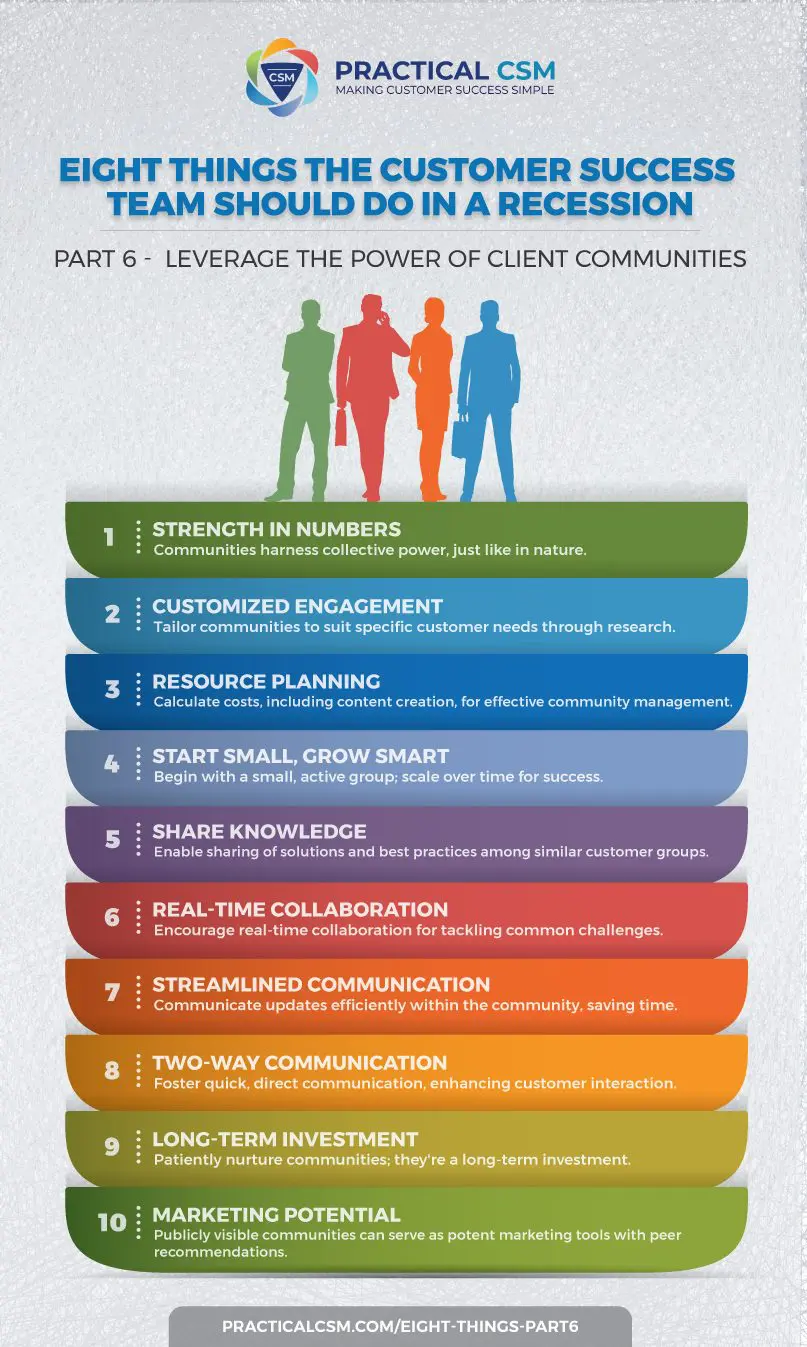Leverage the Power of Client Communities
Eight Things the Customer Success Team Should Do in a Recession – Part 6
Overview
There were a lot of great points made in my recent interview with Nick Mehta, CEO of Gainsight, but there was one aspect of the interview in particular that I think was particularly important. This was the part of our conversation when we discussed the role of the Customer Success Management team during a recession, or during any period of uncertainty where businesses are tightening up budgets and only performing essential activities due to fear of an impending recession, which I think is a good description for the situation we find ourselves in right now.
This article is partially based upon my recent discussion with Nick Mehta, and describes eight practical steps that almost any Customer Success Management team should be able to take when faced with a recession or period of uncertainty. In fact, to be exactly accurate we will discuss seven things to do and one thing to avoid doing. The original interview that inspired this article was recorded and the recording is available from our website here and from our YouTube channel here.
The eight practical steps we will be covering in this article are:
- Proactively Offer Your Help
- Address Your Client’s Current Priorities
- Measure and Prove the Value
- Use Process to Create Efficiency
- Automate Customer Success Management
- Leverage the Power of Client Communities
- Make Your Product an Essential Need
- Do Not Become the Concierge

Leverage the Power of Client Communities
Communities are powerful things. This is something that Mother Nature is well aware of. For example a single bee cannot do much on its own, but a hive of bees can produce significant amounts of honey through collective efforts of the worker bees, who in turn don’t need to worry about protection because their larger bodied soldier bee brothers have that aspect covered. Think of herds of sheep and antelope, or schools of fish as other examples of communities where the individual significantly increases its ability to survive and thrive by being a part of a community.
So OK, how does this apply to our clients in the world of customer success management? Well, as we discussed in the previous section when we were talking about how to automate parts of our Customer Success operations, the needs for and benefits of customer communities will vary dependent upon the products you sell and the types of customers you have. As before, research may be required to determine which (and how many) of your customers would enjoy engaging in an online community and how often they would want and need to use it.
Assuming you find you have sufficient numbers of clients whom you perceive would benefit from a community and would be willing to contribute to its content (because otherwise the whole exercise Is pointless), you will need to determine what types of services you provide within your community and who will monitor, manage and control the various threads that will be likely to be needed. Make sure you cost the running and management of your communities (including potentially quite a lot of content authoring from scratch on a ongoing basis). Also, do not expect your community to be busy overnight. As a general rule start off small, get people going, encourage as much activity as possible and then learn from observation over time.
Customer communities can be great for when you have hundreds or maybe even thousands of customers using the same or very similar versions of your product or products to perform the same or very similar activities to gain the same or very similar results. In this type of situation, customers can share learning experiences, solutions to problems, work-arounds and best practices that have helped them with other customers exhibiting similar problems, challenges and frustrations to the one they have experienced. Like-minded customers who are in the same or similar stage of their journey might even be able to “buddy up” and work in partnership to solve problems and overcome challenges in real time together.
The client community also helps the CSM from a communications perspective. If for example a product is amended to fix a bug, or a new feature is launched that creates additional functionality for users, rather than having to write to each customer to tell them about it, you can simply share the relevant information (perhaps with a video or case study) inside the community platform. And this works the other way too, since not only does it become quicker and easier to communicate to your clients, it can also become quicker and easier to receive communications from your clients.
Working customer communities rarely happen overnight. If you are considering launching a customer community, make sure you are willing to work at it for a long time before you start to see behavior changes within your customer base. You will need to keep at it posting and communicating, signposting and guiding, marketing and promoting it time and again, until little but little you will start to see more natural (ie unforced from your clients) activity occurring. Communities can therefore be time expensive because they need setting up, managing, monitoring and especially they need content. And by the way that content needs to be useful and well written!
As a last thought about customer communities, depending upon the software you use and the types of information you are sharing, it may be possible to make your customer community (or at least some part of that community) publicly visible and available to all. This of course can be a very powerful marketing tool, since it shows off your clients discussing and (hopefully) validating your solutions as being worthwhile solutions to consider for the types of challenges or initiatives your existing clients have purchased it for. Peer reviews and recommendations are naturally much stronger than marketing messages directly created by and posted from the Marketing department of the company itself. If you are going down the client community route, make sure to fully explore what opportunities for marketing that customer community might offer you.
Stay tuned for Part Seven of the “Eight Things the Customer Success Team Should Do in a Recession” article which will be published next month.
Go Back to “Eight Things the Customer Success Team Should Do in a Recession – Part One.”
Go Back to “Eight Things the Customer Success Team Should Do in a Recession – Part Two.”
Go Back to “Eight Things the Customer Success Team Should Do in a Recession – Part Three.”
Go Back to “Eight Things the Customer Success Team Should Do in a Recession – Part Four.”






Leave A Comment
You must be logged in to post a comment.